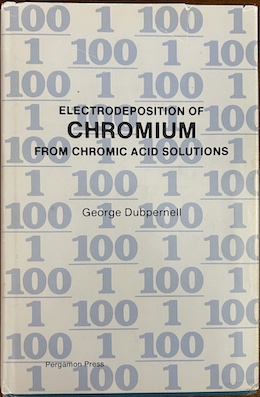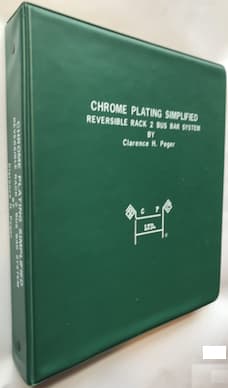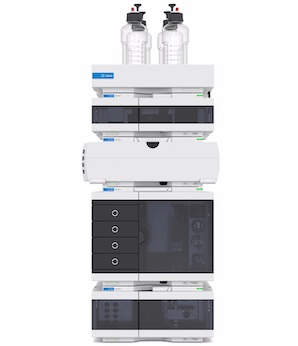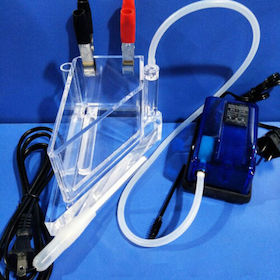
-----
High Contamination in Hard Chrome tanks
Q. We have a hard chrome plating bath where we monitor the surface tension, and lately we have noticed that the surface tension is on the rise, more so than usual.
We are wondering what effect on the solution would there be when a current is applied when either there is no cathode in the tank (i.e., out-of-tank plating) or the anode-cathode ratio is greater than 4:1?
Aerospace - Winnipeg, Manitoba, Canada
2006
for Shops, Specifiers, & Engineers

by Weiner & Walmsley (1980)
avail from eBay, AbeBooks, or Amazon

by Robert K. Guffie (1986)
avail from AbeBooks, or Amazon

avail from eBay, AbeBooks, or Amazon
"Hard chromium plating: A Handbook of Modern Practice"
by John David Greenwood (1971)
avail from eBay

very rarely avail from Amazon
but copies are available in a few libraries)
"A Chromium Plating Bath With The Fluoride Ion"
by Alfred Perlenfein (2013)
avail from eBay, AbeBooks
(as an Amazon Associate & eBay Partner, we earn from qualifying purchases)
A. Unless you have a cooling coil in your tank, the temperature will rise. Temperature will have the greatest effect on surface tension. Chemistry of the solution will be next. Drag in is another possibility.
James Watts- Navarre, Florida
Q. Our tanks are temperature controlled, and the tanks are checked prior to taking a sample to ensure that they are at the correct operating temperature.
We believe that there is a contamination issue, but we are unsure where it would be coming from.
- Winnipeg, Manitoba, Canada
A. Ok, I confuse easily. Why are you checking surface tension? If it is for controlling emissions so you can get by with less exhaust, then that is controlled by an additive which is subject to drag out and possibly consumption or evaporation.In that case, you need to add more additive.
I have never heard of anyone being concerned with surface tension in a hard chrome tank (for aviation) as a QC item.
- Navarre, Florida
A. The possible reasons for rising surface tension generally are: depletion of surface tension additive by the introduction of oil/grease, failing to add surface tension additive as specified, increase of chrome metal in bath, operation at very high current density where solutions is "vaporized" and surface tension additive is lost.
The above assumes that you are using one of the fluorocarbon type permanent additives and not a surfactant type "foam blanket".
process supplier - Great Neck, New York
Q. We are only checking surface tension to ensure we are not violating our environmental license, and not using it as a QC check.
We have noticed lately while performing the analysis, that the color of the hard chrome solution has changed dramatically, and at the same time our surface tension values have also changed dramatically. We believe this to be a symptom, not the actual "disease" so to speak. We are looking into sources of contamination in a hard chrome bath, which was the original intent of my question. I apologize if that was not overly clear
- Winnipeg, Manitoba, Canada
A. Jennifer,
Consider the fact that you are looking for a source of contamination, how can anyone help if we have virtually zero knowledge of your operation. You know, little things like what size and shape are you plating, what base metal, what temp, what concentrations, what additives, what preprocess tanks (especially what rinses) just to mention a few.
Tank color changing to darker could be trivalent going up or a metal contamination or an organic contamination.
If you are not using a fluoride catalyst or additive, I would recommend using porous pot technology for control of the tramp metals. I used Hard Chrome Technologies out of Cleveland, OH as the cheapest adequate source.
- Navarre, Florida
A. I see you have indicated that the solution color has changed. How so? If it has darkened, I would bet that there is a leak in a cooling coil. If your cooling system is running a glycol mixture as the medium, the glycol will reduce hexavalent chrome to trivalent quite readily.
Best Regards,
Kansas City, Missouri
Q. I have experienced a small leak in a heat exchanger in my chromium tank. At the same time this occurred building maintenance was treating the boiler and pipes with a corrosion inhibitor. ChemCal 46130P Sodium Metaborate 7-10% and Sodium Nitrite 65-80%.
I pumped out the tank to change out the exchanger, and clean the tank. I plan to pump the solution back in, and try to plate. Any feedback on how to handle this?
- Fort Worth, Texas
January 25, 2013
Q. Hi,
We have 8 hard chrome tanks with HEEF-25®
One of our tanks (3200 L or 850 gallons approx. / 40" x 84" x 60" deep) has this composition on March 25th:
- 307,6 g/L of chromic acid
- 6,2 g/L of sulphates (SO4)
- 4,35 g/L of Cr3+
- 10,45 g/L of Iron
- 7,8 g/L of copper.
We started at April 12th to dummy continuously with 2 or 3 rods of 3/8" steel x 48" long at 5 ASI
We used 16 lead (94%Pb, 4%Sn, 2%Sb) anodes @ 1 1/2" per rod (cathode).
During the dummying process, we added barium carbonate.
(this barium carbonate has not been used since 7 years approx.)
To lower the sulphates at recommended range : 2,4 - 3,4 g/L, we added 5 kg of barium carbonate each day during 3 days. (April 14-16th)
We pumped the solution on April 17th to clean the sludge at the bottom of the tank and filter it (5 microns) to get back in the tank.
The solution has been out of the tank during 5 days (until 21st April) so it cools to 70 °F approx.
We continued to dummying from April 22th until today.
We took some samples on April 30th to get an analysis and this is the result :
- 242 g/L of chromic acid
- 2,9 g/L of sulphates (SO4) (the barium carbonate get a positive effect to lower the sulphates)
- 25 g/L of Cr3+
- 11 g/L of Iron (approx. the same of last analysis)
- 8,1 g/L of copper. (approx. the same of last analysis)
How can we lower Cr3+, Iron and Copper ?
We used porous pot in the past in other tanks following the supplier guidelines and we didn't get positive effect.
The procedure of porous pot we followed is linked in this email.
What are we doing wrong with our dummying process?
Thanks,
Projects Director - Quebec city, Canada
May 8, 2015
A. Hi Nicholas,
That's really high chrome 3, and same goes for the iron and copper. If my chrome tank had your analysis I'd dump it and start again. Short but sweet advice I know, but you'll spend for ever tinkering with it otherwise and probably not get anywhere. There's nothing wrong with dummying per se, but it's the amount of iron and copper that's too much to remove.
Regards,
Mark
Aerospace - Isle of Man Great Britain
A. That sounds like the same system that I used. With the high level of contamination, you will need to dump and clean the pot at least once a day and probably 2 times a day for several days.
If you are not seeing results, my guess is that the pot is fouled, your voltage is too low or your system is too small for the tank size in that you are probably adding contamination as fast as you are removing.
Immediate help on the trivalent would be to use a large anode area and a very small cathode area at a voltage of at least 6 V.
I would look at using multiple pot systems or a much larger one.
Next time do not let the tank get into such bad shape. It is costing you production as well as quality.
- Navarre, Florida
A. Hi,
I'm agreeing with what Mr James Watt said. But the high copper and iron is not so high, so the plating stuff will have less chrome plating deposit. But the high trivalent is more important to lower it. Use a small cathode and a big anode area. Use 6 volts and check the temperature because that will be higher.
Regards,

Anders Sundman
4th Generation Surface Engineering
Consultant - Arvika,
Sweden
Q. What do you mean by the temperature will be higher?
It will increase?
Did you have any problem in the past when you added barium carbonate to a hard chrome solution to lower the sulphates?
What is the best way to measure the level of trivalent chrome? We use a few laboratories and our chrome supplier also and neither of them have a constant analysis.
Thanks for your answers.
Have a nice day!
- Quebec city, Quebec, Canada
A. Hi Nicolas,
Do you chrome plate onto copper? The copper concentration seems really high to me. We do not usually plate onto copper, but use copper bus bars, and copper concentration in our tanks is around 2 g/L...
We also use barium carbonate to reduce the sulphates concentration in our chrome plating solutions, an had no problems with this so far.
I imagine that the labs you use employ HPLC/ASS/ICP-MS for measuring the trivalent chrome. If the samples you give them are representative of your solution, they should get constant/reliable results.
You can also measure the trivalent chrome in-house. Get first the chromic acid concentration as per usual (titration, I guess). Then take other sample and oxidize the trivalent chrome to hexavalent chrome by heating it in a hot plate with some hydrogen peroxide until it stops fizzing. Leave it cooling and titrate the sample for chromic acid. You can then get the concentration of trivalent chrome from the difference between the two titration figures.
If you follow Anders' recommendation, you should be able to bring the trivalent concentration within the equilibrium range (~ 2-4 g/L).
Check also your anodes. They should have a brown/black film (lead peroxide), which is essential for re-oxidizing the trivalent to hexavalent chrome.
Hope you find this helpful.
Tomas
- Manchester, UK
A. Hi,
The energy which the cathode produces is high.
Barium is great to use to lower the sulphate, by stirring the solution when you add Barium in it.
A regular check by analyzing by the lab is easy. You also see that by the color in solution.
But to always be sure to have low trivalent chrome in the plating solution, set up a small cathode pin and let run for a couple of hours after plating.
The trivalent chrome should not exceed 3.5 g /litre
I prefer 1.5 g/litre.
I know at Atotech they say it will work with higher contamination of trivalent chrome.
Regards,

Anders Sundman
4th Generation Surface Engineering
Consultant - Arvika,
Sweden
A. Hi Nicolas,
If you have high contamination in your chrome tank, you can decant the chrome tank (follow your state regulations). After decant, adjust your chemistry.

Popatbhai B. Patel
electroplating consultant - Roseville, Michigan
Hard chrome bath contaminated with anti-freeze
Q. Hi, I'm looking for some advice regarding one of my hard chrome baths.
Unfortunately the cooling coil sprung a leak and has ruined the solution (Cr110).
Has anyone had this happen, and did you manage to salvage the solution, or is it a new solution? (I have no idea how much antifreeze solution has gone in).
We have our supplier testing it, and they seem to think it is salvageable, but it could take up to 60 days to plate it out. I'm not so optimistic as it currently looks like tar! We are getting a large build up of "something" (looks like black mud, with green film on the underside of it when it is removed - tri) on the cathodes each morning so something is happening. We were told to plate it at 12 v with low cathode area -- there is no gassing at the anodes.
Any advice would be appreciated -- I'd rather replace the solution , but I'm not the one paying for it! Also we are limited to the amount of chemicals we can buy from the U.S yearly, so I can understand the need to try and save it.
Thanks for any help.
malcolm
employee - essex uk
November 26, 2018
A. Hi Malcolm. CR110 is a SRHS bath which relies on partially soluble fluoride sludges settling out in the bottom of the tank, so it seems to introduce even more problems. And I'm not sure the purification attempt is even safe; ethylene glycol degenerates to all sorts of stuff when reacted with strong acids and oxidizers. Google.com talks a bit about the reactions.
Any experimentation should usually be done in a Hull Cell ⇦ huh? or a lab flask, not in an actual multi-gallon production tank, even if there is no possibility of dangerous reactions. My feeling is that purification is not going to be practical, but that you should run experiments on small volumes rather than making a large volume of witches' brew. Good luck.
Regards,

Ted Mooney, P.E. RET
Striving to live Aloha
finishing.com - Pine Beach, New Jersey
Ted can be retained for immediate
answers or long term project help
![]() Thanks for your reply Ted; we are doing tests using Hull Cell, and so is our supplier . We received an email earlier stating they are not confident about saving it now!
Thanks for your reply Ted; we are doing tests using Hull Cell, and so is our supplier . We received an email earlier stating they are not confident about saving it now!
I'm not allowing the plating out test on the tank to be done during working hours as I don't want to work near it!
I'm hoping that the powers that be will renew the solution as I feel it's a waste of time. Fingers crossed!
Thanks again
Malcolm
- Essex uk
A. Hi Malcolm
I wonder why a cooling solution should contain anti-freeze.
But if it does and it contains ethylene glycol (which will almost certainly have reacted with unknown results) it is an organic chemical and cannot be plated out. Carbon treatment is a possibility but unlikely to be successful. I am surprised that your supplier has not said this.
You will save a lot of time and frustration by replacing the solution.
Another question is why you are sourcing chemicals from US.
There are plenty of local suppliers.

Geoff Smith
Hampshire, England
Q. Hi Geoff; sorry I meant it's the catalyst we have to get from the U.S.
I'm not sure I'm allowed to name our supplier on here , but the name begins with A ;)
If you can let me know how we can get it more locally, that would be fantastic! - I'm the plater so I don't get involved with suppliers, etc., so I can pass on any info you have that can help to my relevant people
Thanks,
Malcolm
- Essex uk
Ed. note: We've found that we can't praise or criticize products or suppliers here (huh? why?), but there's probably no issue mentioning the product name in question for more efficient troubleshooting and communication.
A. Hi Malcolm
Searching the web will mostly give you links to sellers of plating kit to amateurs.
I suggest that you contact the Institute of Materials Finishing who will happily advise on the major industrial suppliers. I believe there is a link on this website or go straight to ...
http://www.materialsfinishing.org

Geoff Smith
Hampshire, England
Q. I am maintaining
Chromic acid-283.39
Sulphate-2.7
for my HEEF 25 solutions. Solution is quite 3 year old.
I am not getting more plating on LDA (inside ring), I want to increase it.
I want more brightness and more hardness on my parts.
My parts are spinning rings,
Please provide me what addition I have to do? And in what ratio?
Please suggest best solution to solve my problem
Thanks
- gujarat India
September 19, 2021
A. Hi vishal. We appended your question to this thread because I don't think you'll be able to improve upon Atotech's instructions and be able make their hard chrome plating bath deposit harder and brighter, nor more evenly distributed, than they know how to do.
But what you probably can do is reduce problematic things like iron or copper contamination, excessive trivalent chrome, etc.
Are the parts you are trying to plate the same parts you've been plating successfully for 3 years? If it's a new part, the usual way to get better plating in low current density areas is with auxiliary anodes in those areas and robbers in the high current density areas rather than tweaking the solution.
Luck & Regards,

Ted Mooney, P.E. RET
Striving to live Aloha
finishing.com - Pine Beach, New Jersey
Ted can be retained for immediate
answers or long term project help
Q, A, or Comment on THIS thread -or- Start a NEW Thread

